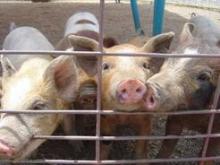Two- and four-legged visitors to an Indiana county fair picked up an unwelcome diagnosis of H1N1 influenza A.
The Centers for Disease Control and Prevention has confirmed four human cases of H3N2v virus with the influenza A(H1N1)pdm09 virus M gene. The viruses are similar to 12 cases identified in 2011 and 1 detected earlier this year (MMWR 2012;61:561).
Two people sought emergency care for respiratory illness on July 12 (the first day of the 5-day fair), and two others were identified as part of the subsequent public health investigation.
All four persons were swine exhibitors or their family members who had close contact with the pigs, and all have fully recovered without hospitalization.
In addition, respiratory specimens from a sample of 12 pigs at the fair were positive for influenza A(H3N2) virus. Preliminary genetic analysis has shown a very high level of similarity between the gene sequences of H3N2v viruses from humans and the H3N2 viruses from pigs, the CDC reported. There was no word on the subsequent health of the pigs.
The CDC is recommending that clinicians who suspect influenza in patients with recent exposure to pigs should obtain nasopharyngeal swab or aspirate in viral transport medium, and contact their state or local health department and request a timely diagnosis at a state public health laboratory.
Antiviral treatment with oral oseltamivir or inhaled zanamivir in suspected cases is recommended.
Health officials also advise that persons who raise pigs or come into close contact with them at fairs or other such summer venues should be aware of the potential risk for influenza transmission between swine and humans.
The four human Indiana cases bring the total of reported H1N1 influenza cases to 17 since August 2011.
Additional information is available at the CDC’s H3N2v website.


